Abstract
To evaluate cotrimoxazole in the treatment of bacterial meningitis, we compared its action with that of ampicillin and chloramphenicol in experimental Haemophilus influenzae type b meningitis. Both trimethoprim and sulfamethoxazole penetrated well into the cerebrospinal fluid of infected rabbits, reaching 40 and 26%, respectively, of their simultaneous serum levels. Levels measured 30 and 60 min after intravenous injection exceeded the minimum inhibitory concentration of this combination for H. influenzae by 10- to 100-fold. The mean ratio of trimethoprim to sulfamethoxazole in cerebrospinal fluid was 1:22. Cotrimoxazole was as effective as ampicillin in therapy of beta-lactamase-negative H. influenzae meningitis and as effective as chloramphenicol for a beta-lactamase positive strain. These findings corroborate favorable preliminary clinical experience reported by others and indicate that cotrimoxazole deserves further study in the therapy of bacterial meningitis.
Full text
PDF
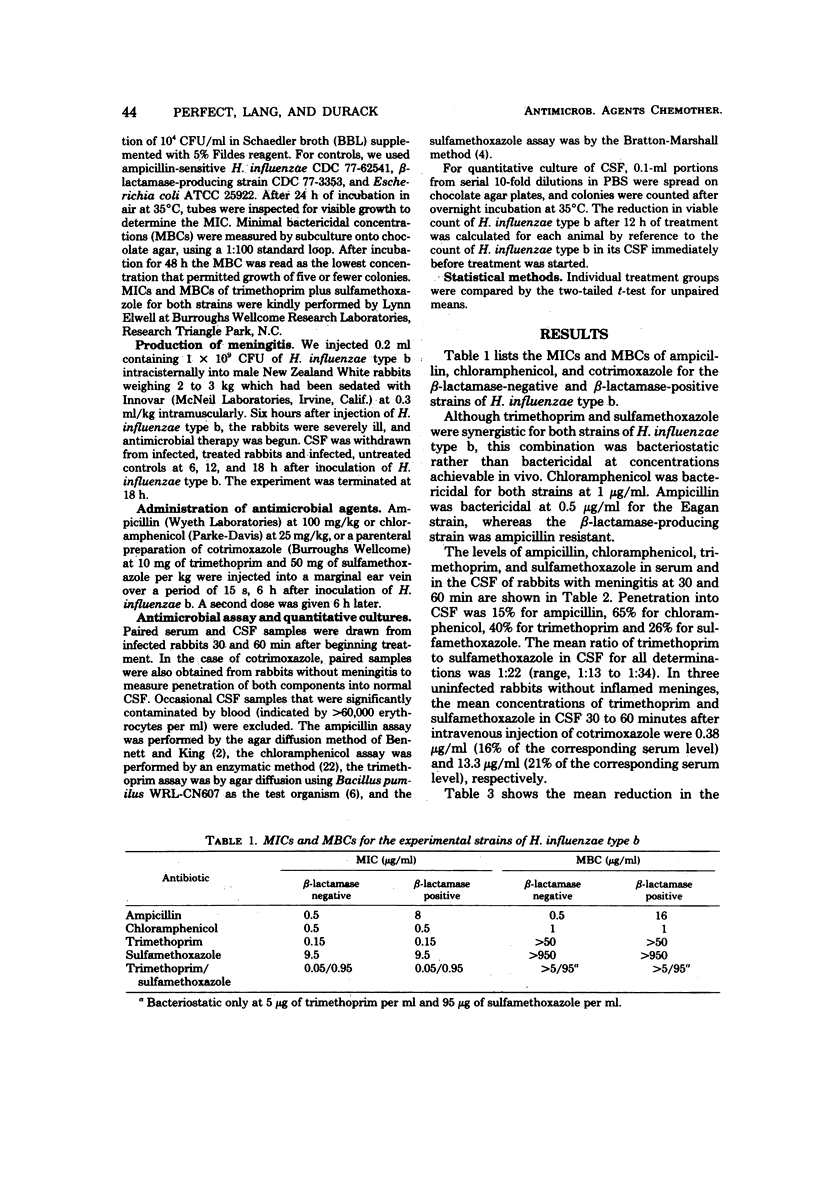
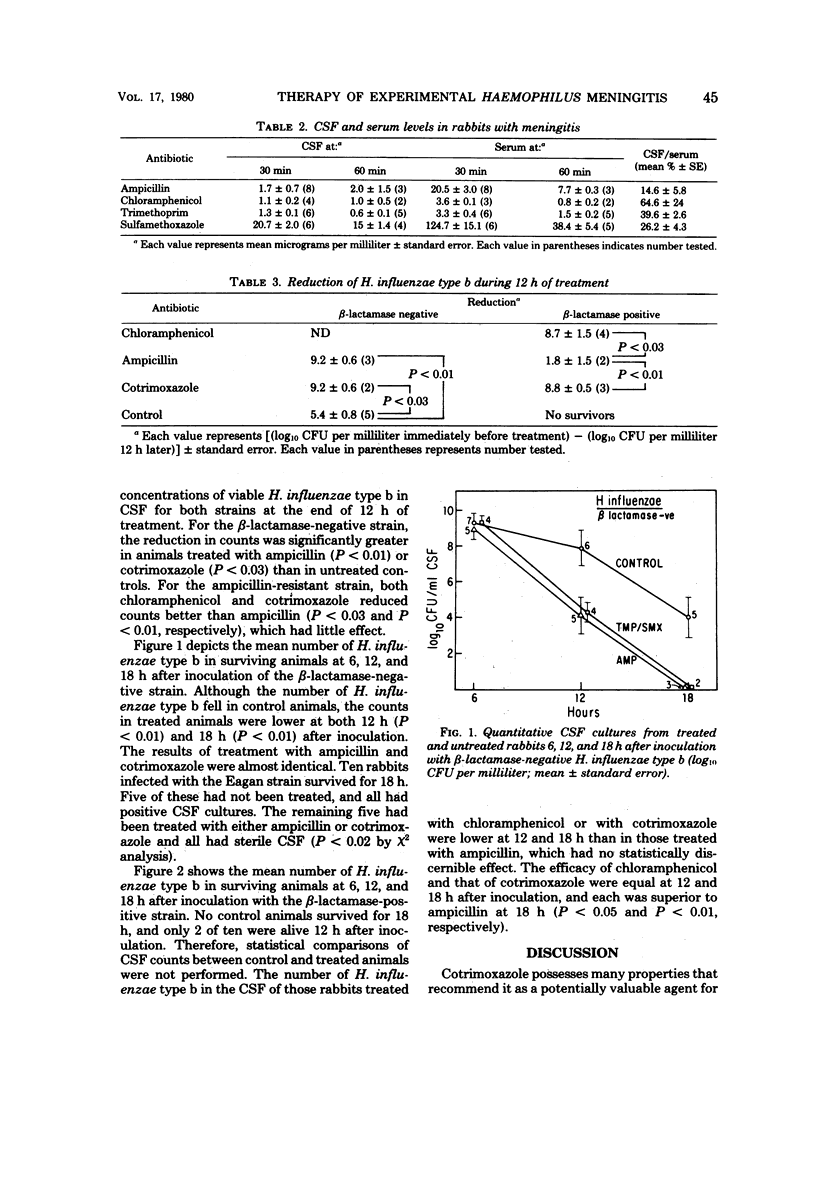
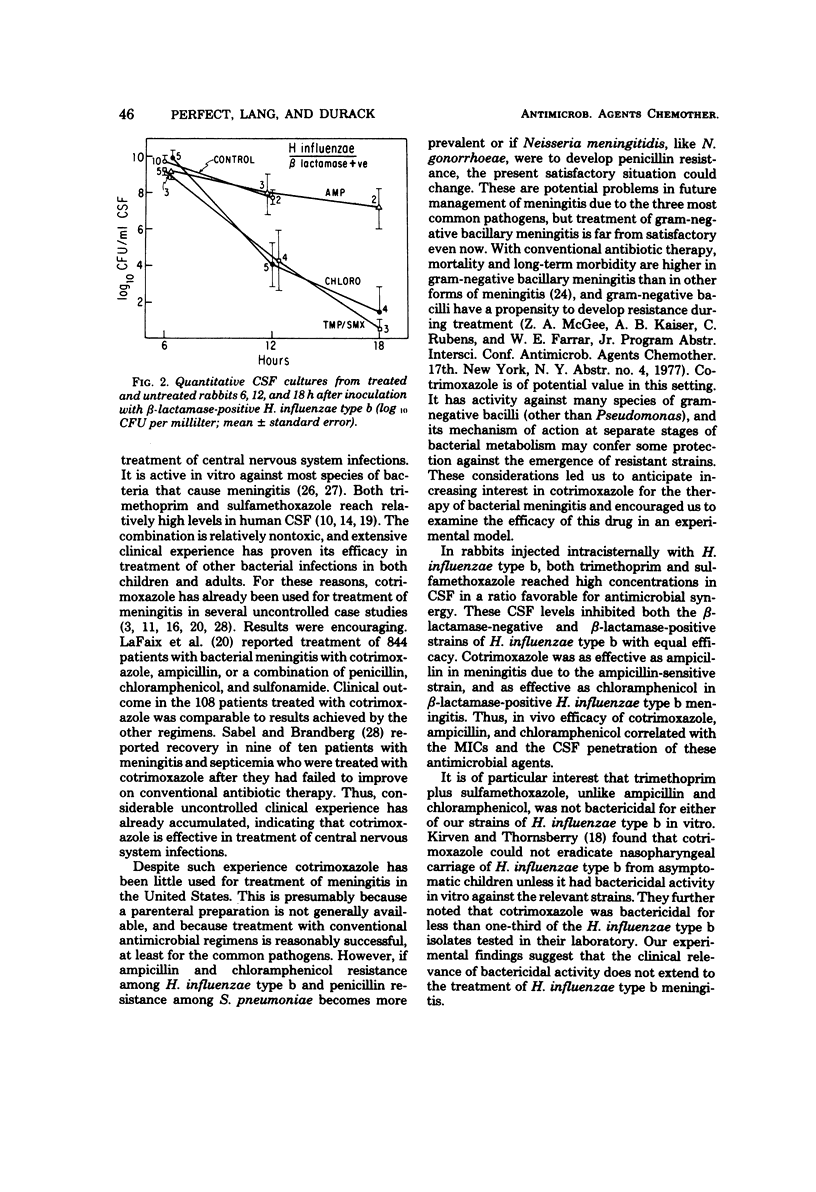
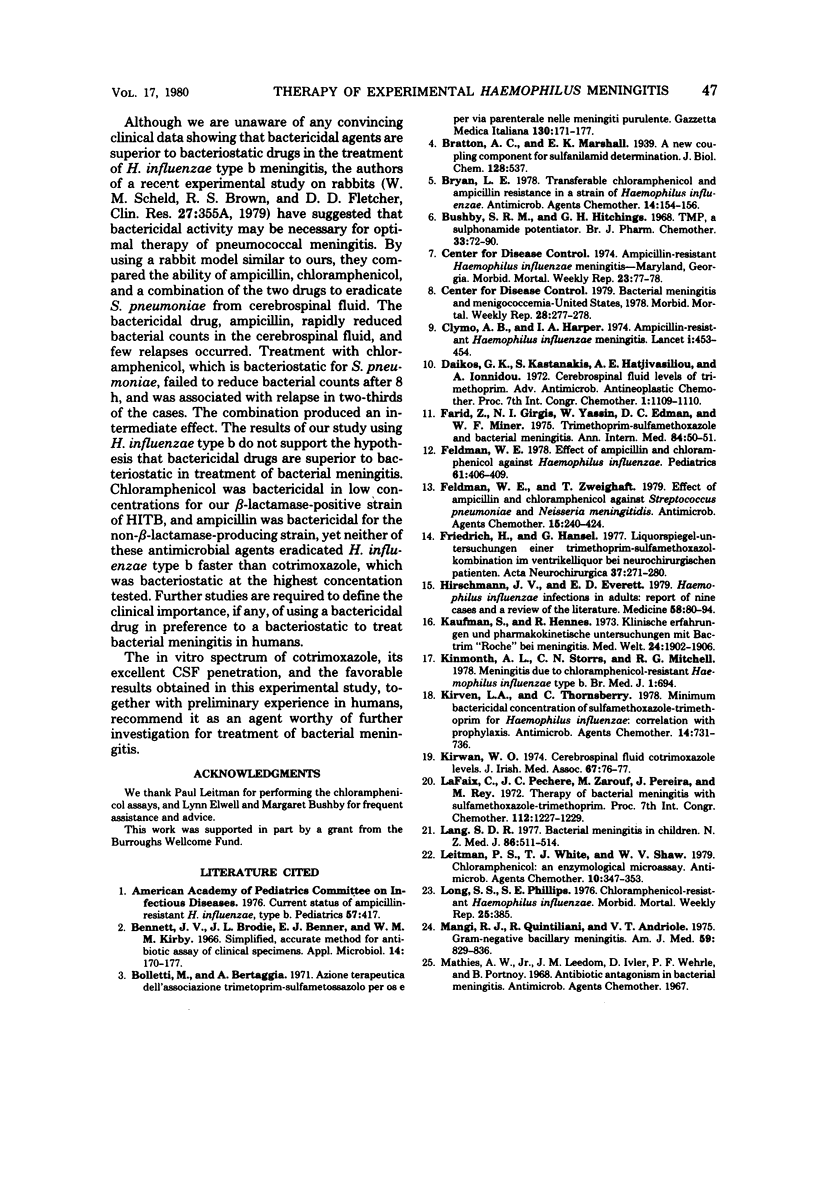
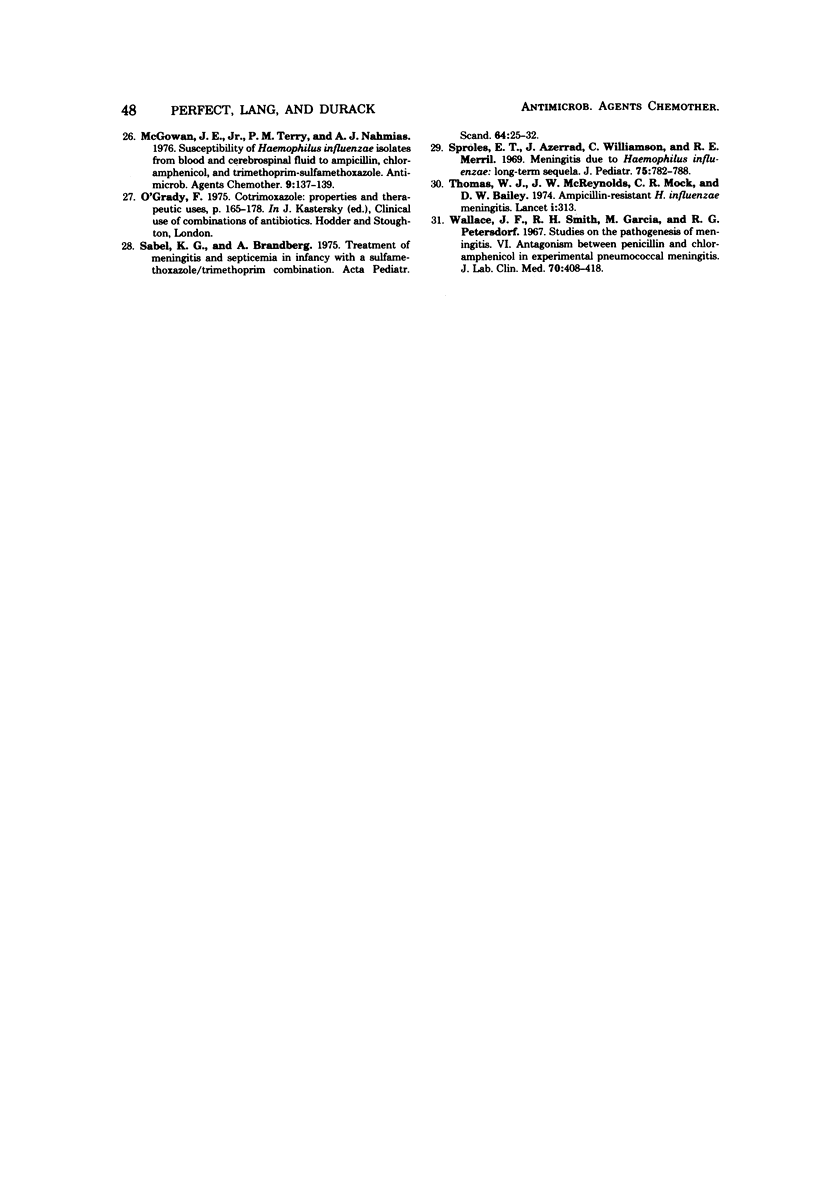
Selected References
These references are in PubMed. This may not be the complete list of references from this article.
- Bennett J. V., Brodie J. L., Benner E. J., Kirby W. M. Simplified, accurate method for antibiotic assay of clinical specimens. Appl Microbiol. 1966 Mar;14(2):170–177. doi: 10.1128/am.14.2.170-177.1966. [DOI] [PMC free article] [PubMed] [Google Scholar]
- Bryan L. E. Transferable chloramphenicol and ampicillin resistance in a strain of Haemophilus influenzae. Antimicrob Agents Chemother. 1978 Jul;14(1):154–156. doi: 10.1128/aac.14.1.154. [DOI] [PMC free article] [PubMed] [Google Scholar]
- Bushby S. R., Hitchings G. H. Trimethoprim, a sulphonamide potentiator. Br J Pharmacol Chemother. 1968 May;33(1):72–90. doi: 10.1111/j.1476-5381.1968.tb00475.x. [DOI] [PMC free article] [PubMed] [Google Scholar]
- Farid Z., Girgis N. I., Yassin W. Letter: Trimethoprim-sulfamethoxazole and bacterial meningitis. Ann Intern Med. 1976 Jan;84(1):50–51. doi: 10.7326/0003-4819-84-1-50. [DOI] [PubMed] [Google Scholar]
- Feldman W. E. Effect of ampicillin and chloramphenicol against Haemophilus influenzae. Pediatrics. 1978 Mar;61(3):406–409. doi: 10.1542/peds.61.3.406. [DOI] [PubMed] [Google Scholar]
- Feldman W. E., Zweighaft T. Effect of ampicillin and chloramphenicol against Streptococcus pneumoniae and Neisseria meningitidis. Antimicrob Agents Chemother. 1979 Feb;15(2):240–242. doi: 10.1128/aac.15.2.240. [DOI] [PMC free article] [PubMed] [Google Scholar]
- Friedrich H., Hänsel G. Liquorspiegel-Untersuchungen einer Trimethoprim-Sulfamethoxazol-Kombination im Ventrikelliquor bei neurochirurgischen Patienten. Acta Neurochir (Wien) 1977;37(3-4):271–280. doi: 10.1007/BF01402131. [DOI] [PubMed] [Google Scholar]
- Hirschmann J. V., Everett E. D. Haemophilus influenzae infections in adults: report of nine cases and a review of the literature. Medicine (Baltimore) 1979 Jan;58(1):80–94. doi: 10.1097/00005792-197901000-00005. [DOI] [PubMed] [Google Scholar]
- Kaufmann S., Hennes R. Klinische Erfahrungen und pharmakokinetische Untersuchungen mit Bactrim "Roche" bei Meningitis. Med Welt. 1973 Nov 30;24(48):1903–1906. [PubMed] [Google Scholar]
- Kinmonth A. L., Storrs C. N., Mitchell R. G. Meningitis due to chloramphenicol-resistant Haemophilus influenzae type b. Br Med J. 1978 Mar 18;1(6114):694–694. doi: 10.1136/bmj.1.6114.694. [DOI] [PMC free article] [PubMed] [Google Scholar]
- Kirven L. A., Thornsberry C. Minimum bactericidal concentration of sulfamethoxazole-trimethoprim for Haemophilus influenzae: correlation with prophylaxis. Antimicrob Agents Chemother. 1978 Nov;14(5):731–736. doi: 10.1128/aac.14.5.731. [DOI] [PMC free article] [PubMed] [Google Scholar]
- Kirwan W. O. Cerebrospinal fluid cotrimoxazole levels. J Ir Med Assoc. 1974 Feb 9;67(3):76–77. [PubMed] [Google Scholar]
- Lang S. D. Bacterial meningitis in children. N Z Med J. 1977 Dec 14;86(601):511–514. [PubMed] [Google Scholar]
- Lietman P. S., White T. J., Shaw W. V. Chloramphenicol: an enzymological microassay. Antimicrob Agents Chemother. 1976 Aug;10(2):347–353. doi: 10.1128/aac.10.2.347. [DOI] [PMC free article] [PubMed] [Google Scholar]
- Mangi R. J., Quintiliani R., Andriole V. T. Gram-negative bacillary meningitis. Am J Med. 1975 Dec;59(6):829–836. doi: 10.1016/0002-9343(75)90468-4. [DOI] [PubMed] [Google Scholar]
- McGowan J. E., Jr, Terry P. M., Nahmias A. J. Susceptibility of Haemophilus influenzae isolates from blood and cerebrospinal fluid to ampicillin, chloramphenicol, and trimethoprim-sulfamethoxazole. Antimicrob Agents Chemother. 1976 Jan;9(1):137–139. doi: 10.1128/aac.9.1.137. [DOI] [PMC free article] [PubMed] [Google Scholar]
- Sabel K. G., Brandberg A. Treatment of meningitis and septicemia in infancy with a sulphamethoxazole/trimethorpim combination. Acta Paediatr Scand. 1975 Jan;64(1):25–32. doi: 10.1111/j.1651-2227.1975.tb04376.x. [DOI] [PubMed] [Google Scholar]
- Sproles E. T., 3rd, Azerrad J., Williamson C., Merrill R. E. Meningitis due to Hemophilus influenzae: long-term sequelae. J Pediatr. 1969 Nov;75(5):782–788. doi: 10.1016/s0022-3476(69)80300-8. [DOI] [PubMed] [Google Scholar]
- Thomas W. J., McReynolds J. W., Mock C. R., Bailey D. W. Letter: Ampicillin-resistant Haemophilus influenzae meningitis. Lancet. 1974 Feb 23;1(7852):313–313. doi: 10.1016/s0140-6736(74)92617-8. [DOI] [PubMed] [Google Scholar]
- Wallace J. F., Smith R. H., Garcia M., Petersdorf R. G. Studies on the pathogenesis of meningitis. VI. Antagonism between penicillin and chloramphenicol in experimental pneumococcal meningitis. J Lab Clin Med. 1967 Sep;70(3):408–418. [PubMed] [Google Scholar]


